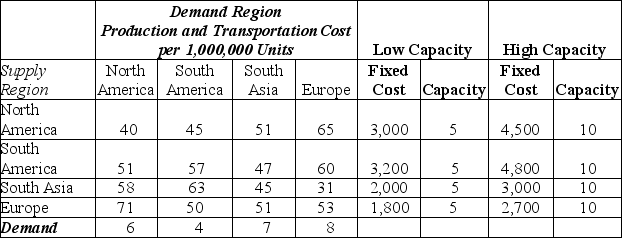Multiple Choice
Future Plastics manufactures plastic products for industrial use worldwide. In order to meet demand, they are considering setting up a facility in each region in order to lower transportation cost and to possibly avoid duties that could be imposed if the product is imported from another region. The disadvantage of this approach is that plants are sized to meet local demand and may not fully exploit economies of scale. Therefore, Future Plastics is also interested in determining the appropriate size of the facility to build in each location and are choosing between facilities with capacities of 5 or 10 million.
The fixed costs of each facility as well as the cost of shipping between regions is shown in the table below. The decision variables are defined as follows:
Xij = quantity shipped from supply region i to demand region j. i = 1, 2, 3, 4 and j = 1, 2, 3, 4.
Yik = 1 if facility k is selected for supply region i; 0 otherwise, where i = 1, 2, 3, 4 for each supply region; k = 1 (low capacity facility) or 2 (high capacity facility)

-The constraint for the South Asia demand region is:
A) X31 + X32 + X33 + X34 =7
B) X31 + X32 + X33 + X34 ≤ 7
C) X13 + X23 + X33 + X43 ≤ 7
D) X13 + X23 + X33 + X43 = 7
Correct Answer:

Verified
Correct Answer:
Verified
Q1: Due to increased sales, a company
Q3: Due to increased sales, a company
Q4: The branch and bound method can only
Q5: If we are solving a 0-1 integer
Q6: If we are solving a 0-1 integer
Q7: Consider the following integer linear programming
Q8: You have been asked to select at
Q9: A _ integer model allows for the
Q10: In an integer program, if building one
Q11: If we are solving a 0-1 integer